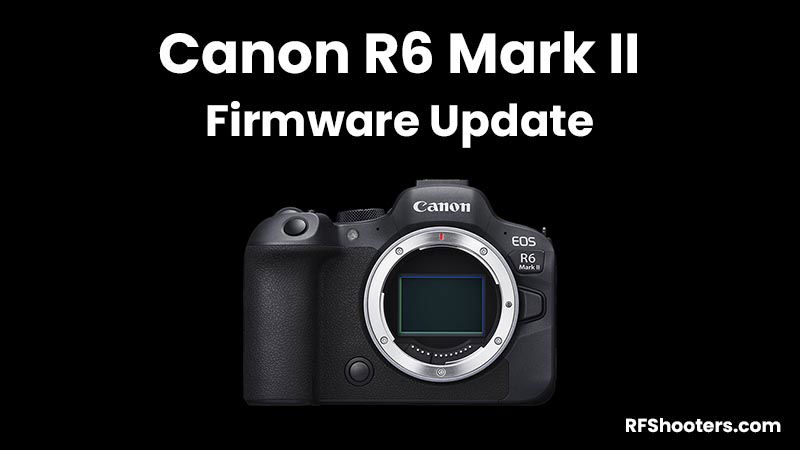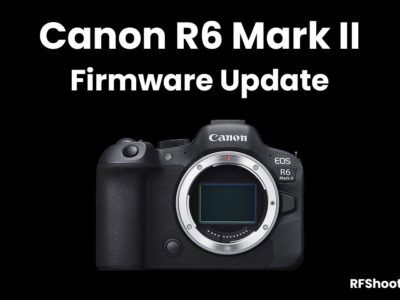The latest version of the firmware for the Canon EOS R6 Mark II is now version 1.6.0

Canon R6 Series Forum & Facebook Group
If you are looking for further help and advice on the Canon R6 Series or would simply like to share your photos and videos, then please head over to our friendly Forum. If you prefer Facebook then we also run the Canon R6 Shooters Group.
What’s New in Firmware Version 1.6.0
Firmware Version 1.6.0 incorporates the following enhancements and fixes:
1. Improves security features. A password must be set initially.
•Adds the ability to review the history of any changes made to the password, network information, or other settings.
*For more information, please refer to the ‘Setting a Password’ section in the Advanced User Guide on cam.start.canon.
2. Enables firmware updates to be performed when the camera is connected to the internet and new firmware is made available on Canon servers.
3. Adds a function that simultaneously protects images when they are rated.
4. Improves AF tracking performance during zooming in still photo shooting with compatible lenses.
*Compatible lenses (as of July 16, 2025):
RF24-105mm F2.8 L IS USM Z (ver.1.1.0 or later)
RF70-200mm F2.8 L IS USM Z
RF100-300mm F2.8 L IS USM (ver.1.0.8 or later)
5. Adds the ability to enable [Exposure Simulation] when a flash unit is attached.
6. Fixes an issue in which Err70 may occur during Bluetooth communication due to interference from other Bluetooth devices.
7. Fixes an issue in which Err70 may occur when repeatedly shooting in the “High-speed continuous shooting +” mode.
8. Fixes an issue in which the camera may stop functioning properly when simultaneously using the touch screen and a button assigned to a custom function.
9. Fixes an issue in which image stabilization may stop working when using an EF lens.
10. Fixes an issue in which HDMI output may momentarily stop when [Screen Off] is activated in the Power Saving settings.
If the camera’s firmware is already Version 1.6.0, it is not necessary to update the firmware.
Firmware Download
You can download the latest R6 Mark II firmware from Canon’s Support Sites:
How to Install the Firmware
Updating the firmware for the Canon R6 Mark II is pretty simple.
When you download the firmware it will include a PDF guide on how to install the firmware.
There are two methods described in this guide, I’d recommend using the card reader in your camera.
If you are downloading to a Mac then when you click on the.dmg file it will mount a drive where you will find the files. Just check in Finder and you should see the mounted drive.
Previous Firmware Versions
Previous firmware versions are always bundled in the latest firmware. So you only ever need to install the most recent firmware version.
Firmware 1.5.0
Firmware Version 1.5.0 incorporates the following enhancements and fixes:
1. Enables functions to be used without limitation in conjunction with the new Battery Pack LP-E6P.
This makes it possible to shoot at the same continuous shooting speed as when using LP-E6NH.
In-camera charging of LP-E6P is also supported.
2. Adds [Protect Images] and [Rating] during FTP Transfer.
3. Adds support for the “Peripheral Coordinated Control”. Peripheral Coordinated Control is now always performed when a compatible lens is attached (there is no need to set it on the menu screen).
* Peripheral Coordinated Control is a function that reduces changes in distortion around the periphery of the image caused by camera shake, which tends to occur with wide-angle lenses.
4. The following issues have been fixed.
4-1. Fixes an issue, in which when performing continuous shooting using the electronic shutter with both the [High-Frequency Anti-Flicker Shooting] and [OVF sim. view assist] options set to [On], Err 70 may occur.
4-2. Fixes an issue, in which when Wi-Fi is disconnected, Err 70 occurs.
4-3. Fixes an issue, in which when performing shooting in high-speed continuous shooting + mode with the [Highlight Tone Priority] option set to [ON], focus may not be achieved when certain ISO speed settings are used.
Firmware 1.4.0
Firmware Version 1.4.0 incorporates the following enhancements and fixes:
1. [No. of shots] in [Interval timer] can now be set up to 9999.
2. Adds [FEM] to [Flash C.Fn settings]. Also, adds [ON/ETTL→M] to [Customize buttons]. Enables the ability to set Flash exposure memory (FE memory) from the camera when using Speedlites without an LCD panel.
3. Adds Protect Images During [FTP Transfer] to the camera menu. Images transferred via FTP can now be automatically protected. The user can determine if images have already been transferred via FTP.
4. The following issues have been fixed.
4-1. Fixes an issue that may cause the camera, in rare instances, to experience a delayed restart after the camera has gone into Auto Power Off.
4-2. Enhances security for FTPS (File Transfer Protocol Security) connections.
4-3. Fixes an issue that, under specific circumstances and in rare instances, may prevent the image from being displayed in the viewfinder or on the screen causing the camera to stop operating, or Error Code 70 may be displayed.
4-4. Fixes an issue that may cause the In-Body Image Stabilizer not to initialize when a vibration occurs when the camera is turned on, and Error Code 20 may be displayed.
4-5. Fixes an issue that may result in Error Code 70 being displayed when the user is shooting in A+ Mode or with the camera set to AI Focus AF.
4-6. Fixes an issue that may cause the card access lamp to start flashing and the camera to not operate normally when shooting small subjects.
4-7. Fixes an issue that may cause the camera to continue shooting when the user presses the shutter button and another button at the same time.
If the camera’s firmware is already Version 1.4.0, it is not necessary to update the firmware.
Firmware 1.3.0
Firmware Version 1.3.0 incorporates the following enhancements and fixes:
- Adds support for RF-S10-18mm F4.5-6.3 IS STM lens.
- Fixes minor issues.
Firmware 1.2.0
Firmware Version 1.2.0 incorporates the following enhancements and fixes:
- Adds support for the RF5.2mm F2.8 L Dual Fisheye lens.
- Adds enhanced security when transferring images via FTPS transfer
- Adds support for the Software Development Assistance Kit (EDSDK/CCAPI).
- Fixes minor issues.
Firmware 1.1.2
Firmware Version 1.1.2 incorporates the following enhancements and fixes:
- Improves the stability of the touch operation control when the [Touch control] is set to [Sensitive].
- Fixes an issue that may result in only one battery being charged when the BG-R10 Battery Grip is attached.
Firmware 1.1.1
Firmware Version 1.1.1 incorporates the following fix:
- Improves the stability of the touch operation control when the [Touch control] is set to [Sensitive].
- Fixes an issue that may result in only one battery being charged when the BG-R10 Battery Grip is attached.





I found that external flash operation on my R6 Mk II was super unreliable to the point of unusability until I installed 1.20 firmware. I have looked around for other references to this being the fix and haven’t seen any. This is surprising since many have complained about the R6 Mk II flash dropping link with external flashes (I have an ST-E3-RT transmitter and three 600EX-RT. The transmitter is connected to the R6 Mk II via an AD-E1 adapter).
Anyways, after a lot of frustration with this issue, I realized I had not yet installed 1.20. 1.20 has zero references to the flash issue, but says “minor issues” are fixed. Once I installed it and them messed with the system a LOT, I am feeling like it is finally OK. If I am right that this is the fix, then I am really bummed that Canon can call the complete loss of useful external flash communication a “minor” issue. Then again, is it just me?
Thanks